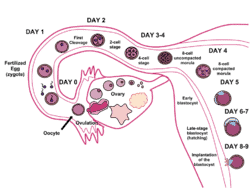
The important point of decision making between transferring embryos when they have cleaved into 8-10 cells rather than later stage when they have become a blastocyst, continues to rage.
Research
Let’s look at research and statistics in the past. Embryos between day 2-4 that fail to develop into blastocysts are usually accepted as “incapable” of achieving pregnancy to term, considering all other parameters are normal. To put it in simple words, there is no difference in pregnancy potential by performing a transfer of embryos between 2-4 days versus not doing an embryo transfer as none of the embryos actually developed into a blastocyst.
One theory states that there is no validity to the above concept, as they believe an embryo would develop better and have a greater chance of pregnancy if its in its natural environment, that is inside the uterus, than allowing it to grow in an incubator.
Future
Science has not developed so much that we can determine whether a particular embryo would develop into a blastocyst, for transfer. In such a case, it would not matter whether such embryos were transferred on day 3 or as a blastocyst. Statistics also show that about 40-50% of embryos formed from the fertilization of eggs from a woman under 35 years, should subsequently develop into blastocysts.
Day 3 transfer
In one theory it is absolutely ok, to transfer three (3) on day 3 to the patient, especially if younger. For that reason blastocyst culture were started only much later nearing the 20th century. Pregnancies still happened, clinics still converted patients and day 3 transfers still underwent. Blastocyst being superior technique was achieved much later and was implemented accordingly.
Why Blastocyst
- Let’s consider the scenario of a routine normal pregnancy. The actual embryo travels between fertilisation and day 5 through the fallopian tubes and into the endometrial tissue. This is where the actual implantation takes place and it is on day 5. This logic prevails to understand better about the increased possibility of pregnancy with a day 5 transfer.
- The day 5 blastocyst has many more cells and ready to blast. So many cells send much more message to the brain and increases the body’s response for improving the implantation of the embryo / blastocyst.
Blastocyst transfer Advantages
The reasons for doing blastocysts transfers are:
- The main advantage for waiting for day 5 or blastocyst is if there were abnormal embryos, they would all die away. So the embryos lasting are the best embryos with the highest proportion of success. This also allows for the transfer of less number of embryos, minimizing the risk of multiple pregnancies.
- Waiting till day 5 also have other advantages
- If the total number of blastocysts that were formed were very few, it indicates an inherent problem of the embryos. This will lead to further investigation of the case, including medication used, and protocol.
- In such cases, the transfer of a single blastocyst should yield a 60-70% baby rate per embryo transferred to the uterus.
Summary:
It is indeed the most difficult process for the doctor and the team to explain the steps and consequences of the program. How many eggs were retrieved, number of embryos formed, then the number of embryos transferred, and the final number of embryos that died through the process.
It is this reason most doctors always prefer to not do blastocyst transfer. This increases the possibility of having more embryos in hand, and able to convince the patient psychologically that they have got a good head start. This also results in more positive thoughts and marginally does increase the possibility of pregnancy because of psychological preparation.


